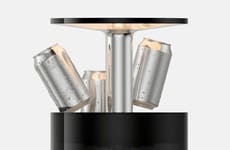
A Team of Researchers Create a Mushroom Robot Design
A team of researchers at Cornell has developed a pair of small Mushroom Robots -- it is because it is powered by mycelium and made for agriculture and space exploration. The researchers are led by Anand Mishra, who is a professor at Cornell Engineering. The team wanted to find the most optimal way to grow mycelium into the electronics of a robot. As a result, it is better described as a biohybrid design as it senses and responds to the environment.
Mishra explained the design project to Dezeen, noting "You could say that mycelium bridges the natural ecosystem and the engineering world, serving as a living interface that connects biology with technology." She adds, "We also believe this technology could have exciting applications in space exploration, where sustainable, self-sensing, and adaptive systems are especially valuable."
Image Credit: Cornell Engineering
Mishra explained the design project to Dezeen, noting "You could say that mycelium bridges the natural ecosystem and the engineering world, serving as a living interface that connects biology with technology." She adds, "We also believe this technology could have exciting applications in space exploration, where sustainable, self-sensing, and adaptive systems are especially valuable."
Image Credit: Cornell Engineering
Trend Themes
1. Biohybrid Robotics - The integration of living mycelium with robotic technology signifies a leap towards biohybrid designs that can adapt and respond to environmental changes, disrupting traditional robotic systems.
2. Sustainable Agriculture - Green technology in robotics is advancing with the development of mushroom-powered robots, offering sustainable solutions for agricultural practices that prioritize ecological balance.
3. Space Exploration Technology - Adaptive biohybrid robots, such as those powered by mycelium, present innovative prospects for autonomous systems in space exploration due to their self-sensing and sustainable characteristics.
Industry Implications
1. Agricultural Technology - The agriculture industry stands to benefit from advancements in organic-powered robotics that support enhanced ecological practices and efficient resource use.
2. Biotechnology - Biotech firms are poised to explore the potential of combining biological materials like mycelium with electronic systems, opening new avenues for creating environmentally friendly technologies.
3. Aerospace - The aerospace industry could incorporate biohybrid systems into its design framework, utilizing adaptive and self-sustaining robotics for exploratory missions beyond Earth.
5.6
Score
Popularity
Activity
Freshness















